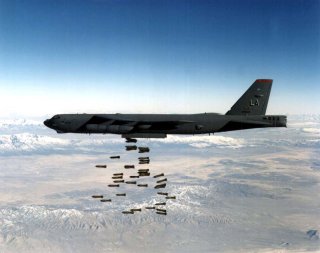How the B-52 Bomber Defends American Troops Across the Globe
Today’s B-52 bomber has been massively overhauled to the point wherein it is almost an entirely different airplane than it was years ago, as either has gotten or will soon get new engines, internal weapons bays, electronic warfare systems, intelligence, and networking technologies and sensors.
Here’s What You Need to Remember: Despite emerging as far back as the 1960s, the bombers are still viable and able to function effectively in combat, due to some maintenance and sustainment efforts.
The United States Air Force’s B-52 Stratofortress has logged a lot of miles since it first took flight some seventy years ago – and now some of those Cold War-era bombers could be described as being on different legs of a world tour simultaneously. Currently, there are B-52Hs deployed to Europe, the Middle East, and the Indo-Pacific Theaters – a testament to the versatility and reliability of the platform.
Last month, in correlation with a Bomber Task Force (BTF) deployment, two B-52H bombers from the 5th Bomb Wing, Minot Air Force Base (AFB), North Dakota, arrived at Al Udeid Air Base, Qatar, May 4. Those bombers joined four B-52s that had been previously sent to Al Udeid in late April. The bombers are there to protect the orderly and responsible withdrawal of U.S. and coalition forces from Afghanistan.
At the time, four B-52Hs were also deployed from the 2nd Bomb Wing, Barksdale AFB, Louisiana, to Andersen Air Base, Guam to conduct operations in the Indo-Pacific region, whilst an additional force of six bombers from Barksdale AFB were sent to Morón Air Base, Spain – marking the third area of operations for the Stratofortresses.
“The speed, flexibility, and readiness of our strategic bombers play a critical role in our ability to deter potential adversaries and signal our unwavering support to our allies and partners,” said Adm. Charles ‘Chas’ Richard, U.S. Strategic Command commander.
“Missions like this provide invaluable training opportunities with our allies and partners to improve our interoperability and demonstrate that our forces are capable of operating anywhere, anytime, to meet any challenge decisively,” added Adm. Richard.
Frequent Flying
The Air Force has noted that bomber task force (BTF) deployments have been a regular occurrence since 2014, and these provide U.S. Strategic Command an opportunity to evaluate and improve the readiness of strategic assets within the Indo-Pacific region. These BTFs provide a persistent, long-term bomber presence around the globe.
“The Air Force is currently working in a complex, dynamic, and sometimes volatile global security environment,” explained Col. Mark Dmytryszyn, 2nd BW Commander.
“It is our charge to regularly conduct these joint and combined security cooperation engagements across different Geographic Combatant Commands and their areas of operation,” added Col. Dmytryszyn.
This BTF deployment has been focused on the employment of the B-52 rather than the B-1 Lancer, which has been used in the past.
“These BTF missions demonstrate the strategic credibility and tactical flexibility of our forces to address today’s matters,” said Dmytryszyn. “As an aircraft capable of employing a wide variety of nuclear and conventional weapons, delivered across a continent-spanning range, employing global joint all-domain command and control systems, the B-52 remains a universally recognized symbol of America’s assurances to our Allies, our partners, and the world.”
The B-52 airframes continue to be the workhorse for these types of missions. Despite emerging as far back as the 1960s, the bombers are still viable and able to function effectively in combat, due to some maintenance and sustainment efforts. Moreover, today’s B-52 bomber has been massively overhauled to the point wherein it is almost an entirely different airplane than it was years ago, as either has gotten or will soon get new engines, internal weapons bays, electronic warfare systems, intelligence, and networking technologies and sensors.
Peter Suciu is a Michigan-based writer who has contributed to more than four dozen magazines, newspapers, and websites. He regularly writes about military small arms and is the author of several books on military headgear including A Gallery of Military Headdress, which is available on Amazon.com.
Image: Reuters

